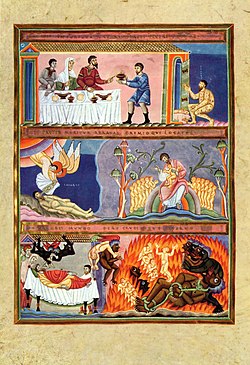Our website is made possible by displaying online advertisements to our visitors.
Please consider supporting us by disabling your ad blocker.
Codex Aureus of Echternach


The Codex Aureus of Echternach (Codex aureus Epternacensis) is an illuminated Gospel Book, created in the approximate period 1030–1050,[1] with a re-used front cover from around the 980s.[2] It is now in the Germanisches Nationalmuseum in Nuremberg.[3]
The manuscript contains the Vulgate versions of the four gospels plus prefatory matter including the Eusebian canon tables,[4] and is a major example of Ottonian illumination, though the manuscript, as opposed to the cover, probably falls just outside the end of rule by the Ottonian dynasty. It was produced at the Abbey of Echternach under the direction of Abbot Humbert.
The manuscript has 136 folios which measure 446 mm by 310 mm. It is one of the most lavishly illuminated Ottonian manuscripts. It contains over 60 decorative pages including 16 full page miniatures, 9 full page initials, 5 evangelist portraits, 10 decorated pages of canon tables, and 16 half-page initials. In addition there are 503 smaller initials, and pages painted to resemble textiles. The entire text is written in gold ink.[5]
- ^ Metz, 55 and preceding pages, followed by Lasko, 98 prefer "between 1053 and 1056" (Lasko), but do not seem to have convinced later scholars.
- ^ Lasko, 98 "the cover must date between Otto III's royal coronation of 983 and Theophanu's death in 991", followed by the Germanisches Nationalmuseum, who add "perhaps 985–987".
- ^ Germanisches Nationalmuseum, Hs. 156142.
- ^ Apart from the short texts on the tablets carried by angels, there are three prefaces by Jerome, and the Letter of Eusebius, all often found prefacing medieval Gospel books. Metz, 64–65
- ^ Walther, 128; Metz has full details
Previous Page Next Page
Codex Aureus d'Echternach Catalan Zlatý kodex z Echternachu Czech Codex aureus Epternacensis German Codex Aureus de Echternach Spanish Codex Aureus d'Echternach French Codex Aureus d'Echternach Italian Codex Aureus Epternacensis LB Codex Aureus Epternacensis Dutch Codex Aureus av Echternach NB Złoty Kodeks z Echternach Polish


